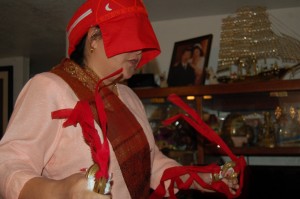
A Hmong shaman dressed in an ornate red and pink costume is standing in a crowded living room in Winton, a small Central Valley town near Merced. She sways back and forth rhythmically as she shakes small ceremonial bells over a young pregnant woman. The woman sits quietly, with a rope lightly tied around her stomach. Her rope connects to another rope -- wrapped around the belly of a newly slaughtered pig that lays on a sheet of plastic on the living room floor. For the next two hours, the shaman chants prayers to the spirit world, offering the slaughtered pig as a sacrifice in exchange for a healthy birth. Throughout the ceremony, the shaman's husband burns pieces of paper money as offerings to the spirits.
Afterward, the pregnant woman and her family prepare for a feast. May Yang, the shaman, explains that this ceremony is the Hmong version of prenatal care. "This ceremony was to help the mother and baby," Yang said through a translator.
More specifically, to help their souls separate. Yang explained that the slaughtered pig was an offering to the spirits so that they would assist in the birthing process. It's part of their customs. Traditionally, in Laos, the Hmong were always more likely to visit a shaman than a doctor when they were sick or needed prenatal care. So when Hmong refugees began resettling to the Central Valley after the CIA's Secret War in Laos, they didn't go to the doctor.
The Hmong traditionally believe that if the body is sick, the soul is sick. So to heal the body, you must first heal the soul. Additionally, many Hmong were distrustful of western practices when they first arrived to the U.S., so they refused to get treated in hospitals, unless it was a crisis. That led to the Hmong filling up emergency rooms at local hospitals -- and it left doctors struggling to understand how to treat them.

But that's been changing ever since a non-profit called Healthy House Merced started a program that teaches shamans the basics of western medicine. Now shamans like May Yang visit Mercy Medical Center to learn things like what x-rays are, what heart monitors do, and when to call for an ambulance. "I learn about the disease," said Yang about the program. "I learn about diseases like Hepatitis B. And I learn about strokes, how it happen to human's body."
